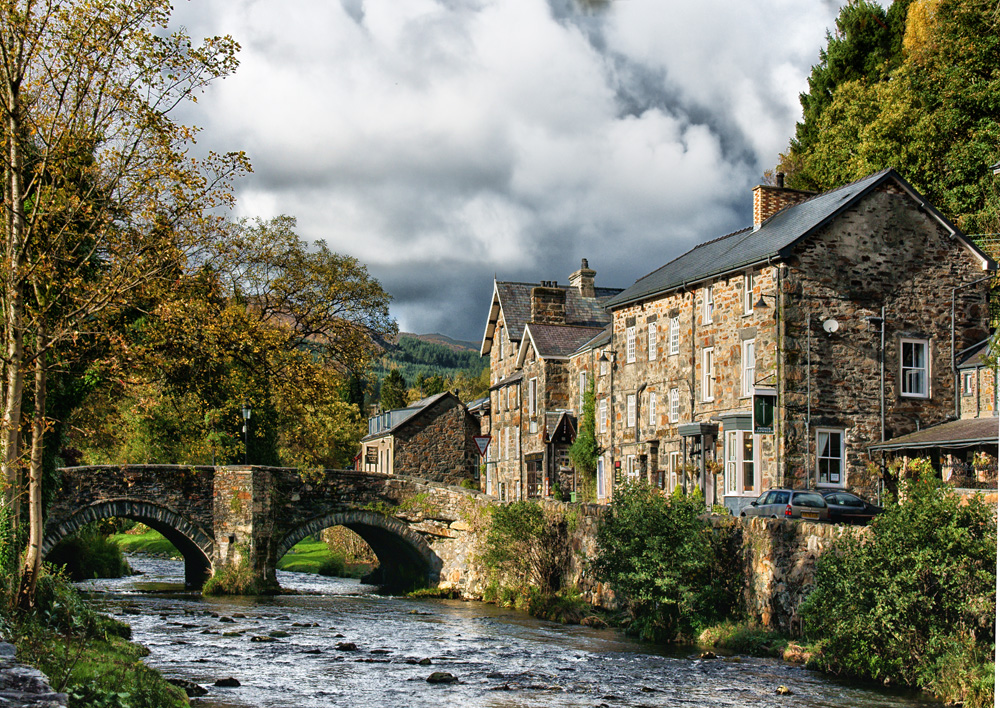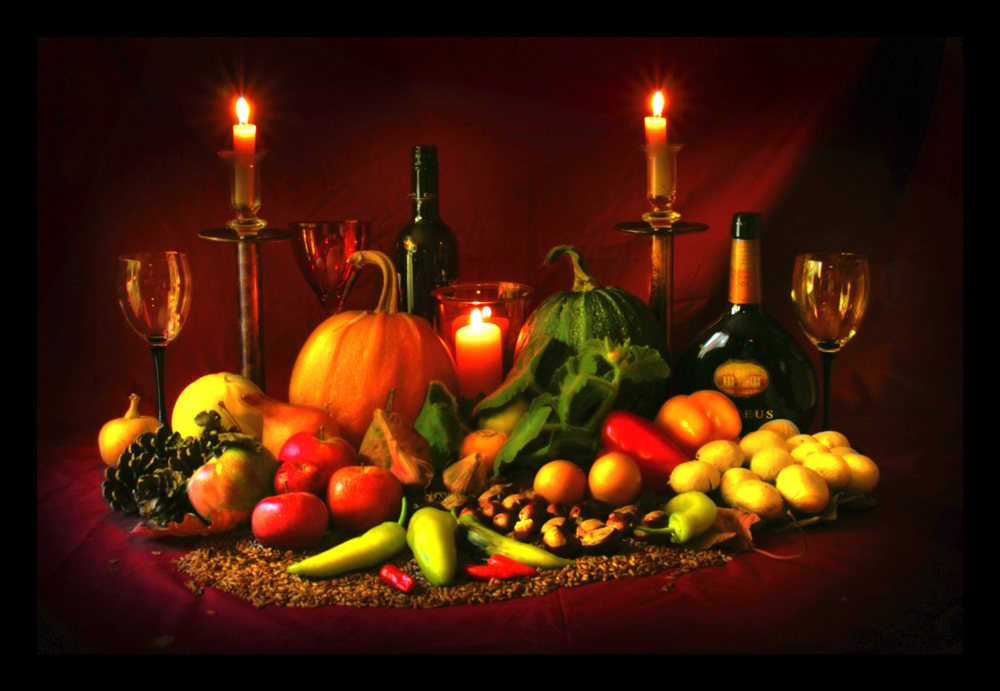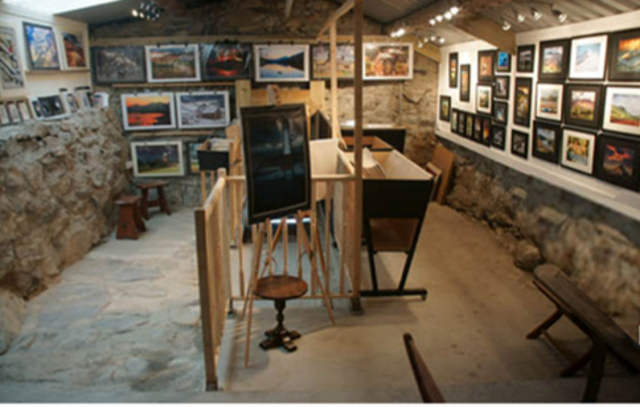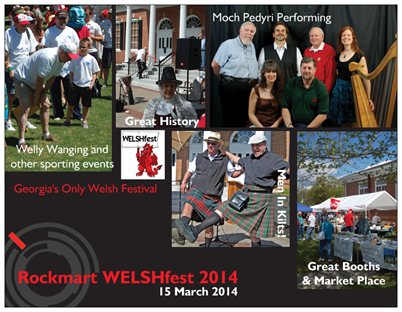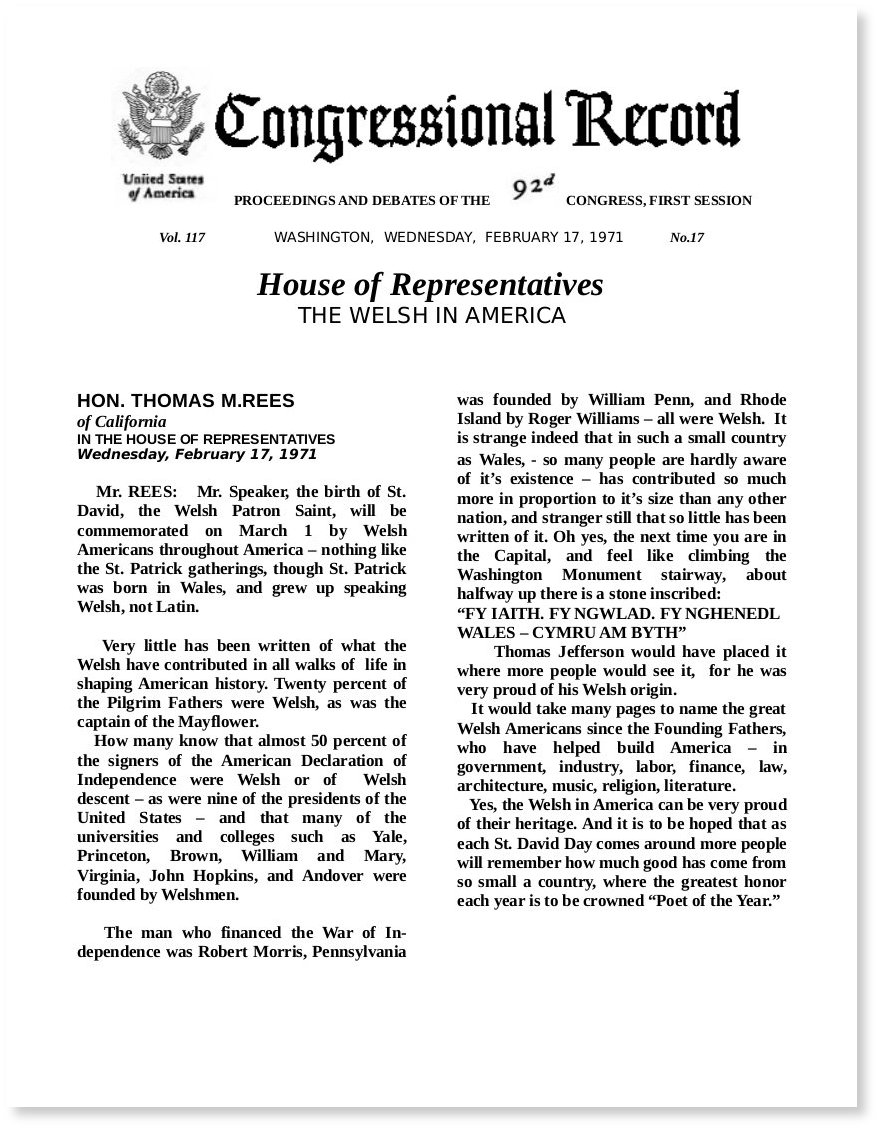Blogs
Dowlais RFC T-shirt - Diolch Ralph Jones - Predict the Scoreline Wales v Ireland on our Wales 2014 Grand Slam Group!!!
By Ceri Shaw, 2014-02-04
Diolch Ralph Jones for the superb Dowlais RFC tshirt, tie and Rugby Addicts calendar. They arrived in the mail yesterday. I will wear the tshirt with pride between now and the end of the Six Nations. Speaking of which.....you will plainly see in the photograph above that I am pointing at the calendar entry ( highlighted ) for the Wales v Ireland match this Saturday. This is a reminder that, if you haven't already, it's time to post your scoreline predictions in the Wales 2014 Grand Slam Group. Here is the url:- Saturday, 8 February Wales v Ireland (14:30 GMT)
An Interview With Snowdonia Photographer and 'Oriel Hafod Ruffydd' Proprietor - Graeme Pettit
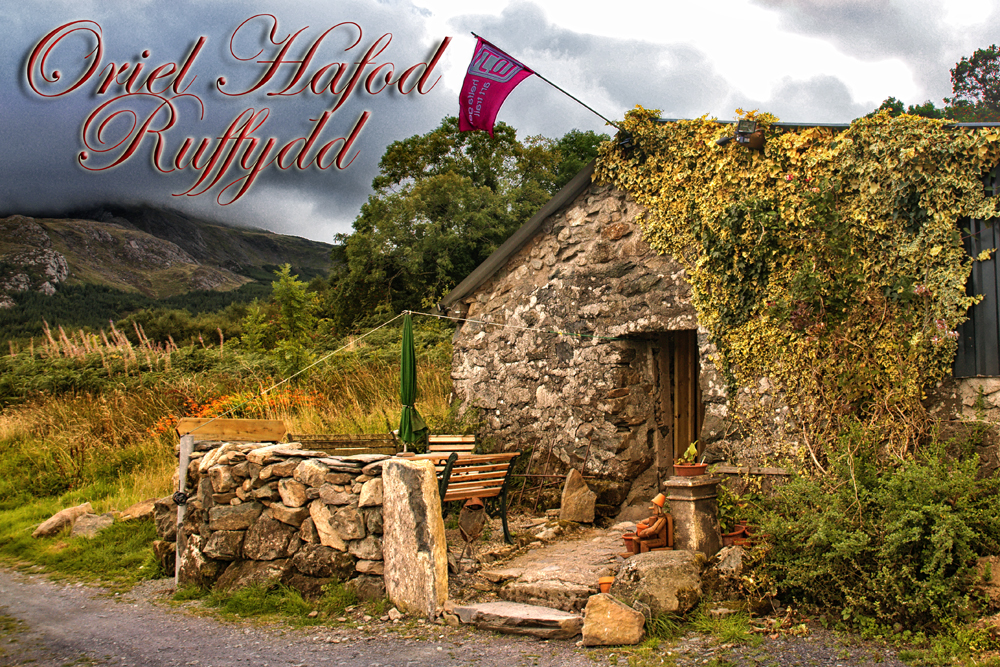 AmeriCymru spoke to Graeme Pettit, photographer and owner of the Oriel Hafod Ruffydd gallery in Snowdonia, north Wales. The gallery is situated near the village of Beddgelert ( famed for the legend of the faithful hound ) and features photographic works by Graeme and others.
AmeriCymru spoke to Graeme Pettit, photographer and owner of the Oriel Hafod Ruffydd gallery in Snowdonia, north Wales. The gallery is situated near the village of Beddgelert ( famed for the legend of the faithful hound ) and features photographic works by Graeme and others.
Visit the website here:- Oriel Hafod Gruffydd for a full list of attractions.
( click on the pics below for full size images )
Winter view of Snowdon from the gallery
AmeriCymru: Hi Graeme and many thanks for agreeing to be interviewed by AmeriCymru. You own and manage the 'Oriel Hafod Ruffydd' in Beddgelert north Wales. Care to introduce the Gallery and surrounding area for our readers?
Graeme: The gallery is the culmination of a dream which began when I was out photographing the moorland at the end of a long deserted track in Mid Wales, where I found a tall house end wall, leaning outward, but heavily buttressed, and a tree growing next to it. I sat down for lunch, kicked the grass, and exposed a quarry tile floor. I was working full time at the time, but had one of those what if moments. On returning home, I described it to my wife, who said Im not moving anywhere unless it has a roof on it to which my reply So we can move then?. Two years later, and 170 locations looked at, we bought the property we are in. I sat on a rock outside, looking at the views and watching the light change, and decided to do something else with my life there and then that was in 2010.
.
We are located about a mile North of Beddgelert, in Snowdonia, halfway along the new Lon Gwyrfai path between Beddgelert & Rhyd Ddu. We can see down the valley 20 miles to Cadir Idris, have Snowdon to the North East, and mountains all around us astonishing vistas, ever changing weather, and a valley with a microclimate all of its own. I am very interested in old folk tales and mythology, and the Beddgelert area is heaving with it. Cwm Meillionnen, in which we sit, is known as the valley of the fairies, and there is a tale of a silver purse, Arthurian legend, and of course, Gelert himself, to name but a few. Plenty there for inspiration!
.
.
The gallery building is full of (as described by visitors) rural charm. We are not white walled, wooden floors and perfectly lit ceilings. It is an old stone built barn possibly as old as the house we live in dating back to the 1500s. I have left the old sloping stone floor in part, and you have to duck as you enter through the door but inside, we hope visitors find a hidden gem something unusual, and that they wouldnt expect to find in the middle of nowhere. We are adding to it daily having opened in September 2013, and been very pleasantly surprised by the traffic we have had and the level of sales to date.
Whilst we do have parking at the gallery, most of our visitors are walkers, or those who found us via Helfa Gelf (the North Wales Art Trail). We welcome dog walkers, cyclists and anyone who cares to visit in fact, some of our first customers were folk who had got lost in the forest and just chanced upon us before we opened officially.
We offer hot and cold drinks, and are about to expand the catering side to cover hot snacks requested by walkers last Autumn. We found catering brought customers who may not have otherwise wandered off the path, and the investment has paid for itself in a very short time.
.
 Approach to the gallery - building on left
Approach to the gallery - building on left
AmeriCymru: What images and other artwork can people expect to find on offer at the gallery? Do you specialise in local images?
Graeme: When we opened, about 20% of the work offered was from my Welsh travels the rest was NZ, USA, Thailand, Ireland, and the UK landscapes, travel, nature and transport were key themes. The proportion is getting on towards 50% Wales now, and only set to grow further. My wife paints in oils, and her work will go in, and we have had interest from other local artists of various disciplines, so we intend expand to cater for the variety over the course of the year. We are beginning to specialise in images of Northern Snowdonia, with a very local emphasis. Whilst all the work on show at present is my own, I am obtaining permission to offer some historic prints, and have a growing stock of local views by painters of the last century I hope to have these on show during the summer perhaps for purchase.
.
 | I like to go beyond photography, so I am no purist. The digital darkroom affords me wonderful creative opportunities |  |
.
.
I like to go beyond photography, so I am no purist. The digital darkroom affords me wonderful creative opportunities to come up with work based on a photograph, but taken beyond into more of an art style. I also sculpt in wood, found items, and make things in metal, so the variety of what is here on offer, is only set to increase. That said, the focus will be my photography work.
.
Gelert legend - faithful hound
AmeriCymru: Tell us a little bit about yourself. When did you first become interested in photography? How do you go about selecting and setting up your shots?
Graeme: I was an irritation to my grandfather as a small boy he was a keen horticulturist, but I wasnt interested in his prize winning Chrysanthemums and Carnations, and kept getting in his way after I had done the watering for him, so he gave me his camera, and told me to go learn how to take pictures and that started it sometime in the 1960s. He developed the films for me, and it seems they were not bad so we shared a few moments that way instead. As a student, I had to document my Forestry work as I was qualifying, so found myself with all sorts of challenges on which to hone my skills later, I ran a rather large railway website, highly demanding of images, and on my tours around the UK, began taking landscape and wildlife photographs. I had spent the last 32 years working with people within the UK prison system. Many are very creative in their own right with words, with art, and good with their hands. My work was in the education and workshop sides toward the end of my career, so I had time to discuss things with people, and became interested in faces. Through candid street photography in the Midlands of the UK, recording daily life, I began to do portrait work also, and there is a studio at the gallery for visitors and pet photography. I also do commercial work since turning professional a couple of years ago. It has been a long slow haul, and nigh on 50 years of learning the craft of photography for me.
.
.
I have a wide and varied taste musically, and something is usually playing around me often, that sets a mood emotionally, and I then take photographs to express that feeling. Wales is less than renowned for good weather, but it is a myth, and for the most part, has been kind to me Ill go out regardless of the weather, and always find something lensworthy. The concept of the weather being good, depends what you want to do when out in it and so long as you dress for it, almost anything can be achieved! I like my landscapes to have cloud cover the light tends to be more dramatic. I might be up on the hills at stupid oclock in the morning to get a shot Ive seen on a less good day, but often, my works are opportunistic the cameras live in the car most of the time, and I often see tantalising glimpses of something good so take my chances when I can get them. That said, I sometimes have an idea and try and create it. One still life image, A Feast for Bacchus took me two weeks to set up and get right but it is just the dining room table and light between two curtains from the window outside I wanted the feel of an old master, but it is for others to decide whether I achieved it.
.
AmeriCymru: The gallery offers a range of other services: photography and software workshops, accommodation catering etc. Can you tell us a little more about these?
Graeme: We have a studio at the gallery I use it for product work, pets, people portraits, and still life/abstracts amongst other genres. As we develop our accommodation, we will be running courses in camera use, studio work, image processing and more some may be residential, others day based. The catering side is in its infancy my wife had the bright idea of offering hot drinks at the end of last summer to our gallery visitors, so invested in a coffee machine we sold out exceptionally quickly over the autumn, and the drinks brought viewers to the gallery which may have otherwise walked by. Chatting, some asked about food so we will be introducing hot food in a limited way once we have approval from the authorities. We bought the property with outbuildings the gallery occupies what used to be a milking parlour, creamery and stalling years back. Another is used as a workshop, where I do wood and metalwork sometimes artistically. We have been living in an attached Swedish style wooden cabin for the past year, whilst we have been doing up the 500 year old house on site and it is the cabin, and a small stone built annex which will form the core of our self catering accommodation the cabin sleeps 4-6, and the annex, a couple. We have had a lot of interest from art groups due to our spectacular location and ever changing light so we will have to see what the future brings. We are slowly moving into the house as our builders leave rooms
.
AmeriCymru: Are there any photographers whose work has inspired your own and who you would like to mention here?
Graeme: I have been inspired by so, so many over the years the classics, who shall remain un-named bar one, and many of the more modern image makers. In historic terms, I have always loved the pioneering work of O Winston Link the great railway photographer, but in the modern age, something can be learned from every image I see. I am impressed and inspired by the works of :
David Nitsche (USA) I love this chaps whole approach - his humour, creativity, and inherent simplicity of image underlies a phenomenal amount of work and experimentation. His work is always a pleasure for me to view.
John DeVaul (USA) I was first introduced to this mans work through his Light Painting set - almost HDR, but more - done with a superb subtlety and excellence of execution
Troy Paiva (USA) A friend in the US put me on to Troys inspirational night photography a few years back. His website "Lost America" is colourful, beautifully presented, and contains some truly excellent work - but that I had similar subject matter! If you want to see the best in contemporary night photography, visit Troys site - you wont be disappointed.
Another guy I love is:
James Ravilious (UK) I was introduced to this mans work through a friend and mentor. Based in Devon, and with much of his time spent out capturing rural life, he has caught an age quickly passing, and documented it for posterity - Beautiful images of daily life.
I have spent many hours in his back yard, but cannot find what he gives - perhaps I just don't feel it, perhaps I am trying to be too complicated in my approach - but these images are simply exquisite in every way to my eyes.
Each of these people has something special their own, unique take on their craft. I would do them and myself an injustice to copy their styles, but their dedication and attention to detail is something I do wish for myself.
.
.
.
.
AmeriCymru: What's next for Graeme Pettit? Any major plans for the future
Graeme: Must learn to speak Welsh that is major. Im a bit long in the tooth, but am trying! It is very early days for us, living and working in Snowdonia. We need to consolidate on what we have so far by way of the gallery and commercial work, and get the self catering up and running. I suppose my major plans probably include developing the studio side and getting to the tops of more mountains in the shorter term, and expanding my photography of the beautiful Welsh landscape, but mumblings have been made by her indoors and there could be a few trips abroad coming. I would love to visit Iceland and Japan at some point, and return to New Zealand for another road trip, but I suspect we will end up on another roadtrip USA we are due one. It will either be New England/Canada/Nova Scotia, or a run from Chicago to New Orleans we have done almost everything east of the Appalachians that said, I would love to visit the Carolinas again Catfish is my favourite food! But to go in search of the Blues, would suit me fine!
.
AmeriCymru: Any final message for the members and readers of AmeriCymru?
Graeme: If you are a creative soul, then my advice is to appreciate and learn from the work of others, but to choose your own style and take it as far as you can. I would thank AmeriCymru readers for the good welcome and interest, just as I have found the natives of Wales so to an invading Englishmannow, who should I support in the 6 nations rugby tournament when Wales play EnglandLOL.
If you are interested in seeing my work, please either visit the gallery itself, or my website - www.graemesdesigns.com
I also offer a limited number of works through Fine Art America -
http://fineartamerica.com/customshop/graeme-pettit.html
.
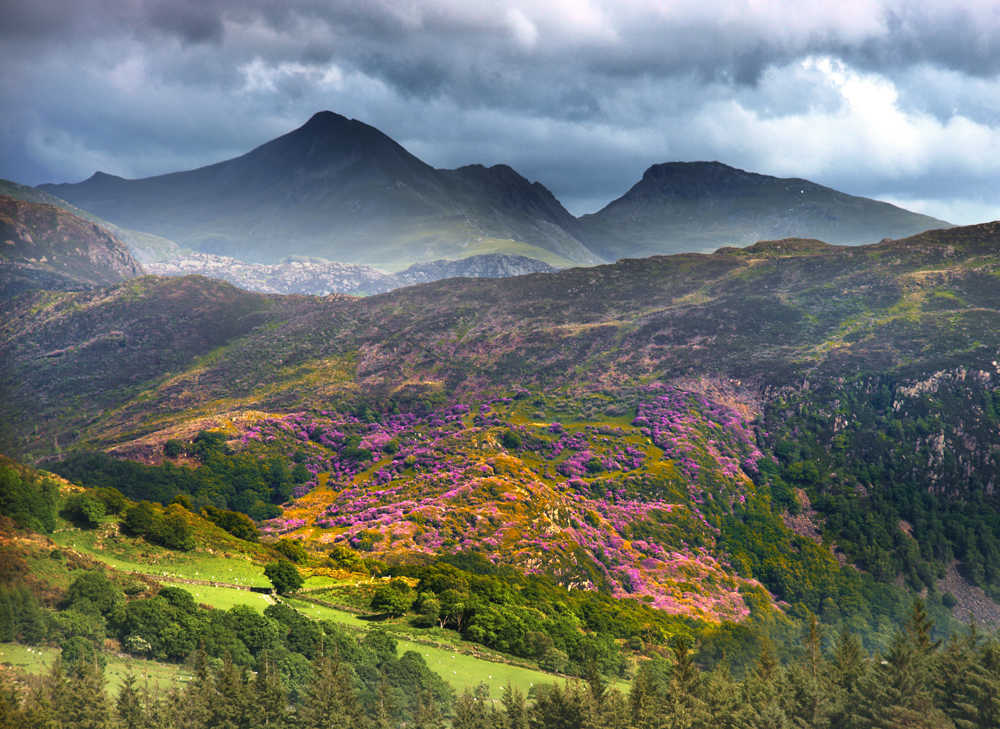 A view SE from the gallery over the Moelwyn range
A view SE from the gallery over the Moelwyn range
February 2014 ISSUE No. 2 WELSHfest 2014
| |
|
|
" Yes, the Welsh in America can be very proud of their heritage. And it is to be hoped that as each St. David Day comes around more people will remember how much good has come from so small a country, where the greatest honor each year is to be crowned Poet of the Year. "
...
The renowed historian Gerald Morgan has published an informal, wide-ranging guide to Wales. Looking for Wales (Y Lolfa) is a pocket-sized introductory guide for the curious and inquisitive reader.
...
...
How did dragons, goats and leeks become symbols of Welsh identity? Did Cardiff really want to become the Welsh capital? And where did all the Joneses come from? Looking for Wales answers these – and other – questions while also providing more conventional information on Welsh castles, churches as well as Welsh music, literature and sport.
“Looking for Wales is presented as an introductory guide to Wales, but I would argue that it’s a must-read for every Welshman,” says the author Gerald Morgan. “I can promise any Welshman or Welshwoman, however learned they may be, that there’s something in this book they don’t know about their country!”
Every page is informed by Gerald Morgan’s lifetime interest in Wales and its culture. The author is a respected historian, teacher and author who admits that he has “been in love with the history of Wales since I was ten years old…”. His other published works include Castles in Wales and Ceredigion: A Wealth of History.
“You may think you can survive without knowing about Winston Churchill and the Welsh goat, about Edith Mair Leonard, John Graham Chambers or Samothes, but I would like to persuade you otherwise.”
Similar to A Brief History of Wales, another one of Morgan’s popular guides, Looking for Wales is an easily digestable, pocketable and affordable introductory guide to Wales, priced at £4.95.
Gerald Morgan lives in Aberystwyth. After teaching English at Ysgol Maes Garmon, Mold, and at Ysgol Gyfun Aberteifi, he served 22 years as headteacher first of Ysgol Gyfun Llangefni and then of Ysgol Gyfun Penweddig, Aberystwyth. A second career saw him teaching Welsh and local history in Aberystwyth University. He has published numerous books and articles on a wide range of subjects, focussing on Welsh history.
Welsh First Minister To Visit New York - Dylan Thomas 100th Anniversary Celebrations
By Ceri Shaw, 2014-01-29
![]()
AmeriCymru spoke to Welsh poet and Seventh Quarry poetry magazine founder and editor Peter Thabit Jones about plans for the forthcoming DT100 ( Dylan Thomas 100th Anniversary ) celebrations in New York and other US cities.
"Dylan Thomas is a cultural icon around the world and a poet who made a major impact on poetry itself. In many ways, poetry was never the same after the publication of the astonishing 18 Poems in 1934 and 25 Poems in 1936. For Wales, it is a great opportunity to celebrate his life and works and to put the spotlight on the main places of his inspiration, Swansea and Laugharne, indeed the whole of Wales."
![]()
Two Men. Two Quests. Two Centuries Apart.
Four Ways To Experience The Search For A Lost Tribe.
Album. Book. Film. App.
In 2012 I embarked on an investigative concert tour of the American Interior, retracing the steps, and looking for the grave of a relative called John Evans.
John Evans left Wales for Baltimore in 1792 and walked into the wilderness of the Allegheny mountains in search of a lost tribe of Welsh-speaking Native Americans, believed to be the descendants of Prince Madog.
Over seven eventful years, with very little in the way of resources, he embarked on a series of incredible adventures, lived with several First Nation tribes and left a trail of political chaos from which America never recovered. I took his cue and travelled through the Midwest playing gigs and writing songs. In St Louis I picked up Kliph Scurlock from The Flaming Lips, who joined me on drums. We powered up the Missouri River by boat, playing more shows on the shore. In Omaha we went to Mike Mogis's Arc studio and cut a record, then carried on upriver to play the UMOnHOn and Fort Berthold reservations.
Dylan Goch who directed a film called 'Separado!' about my previous investigative concert tour joined me again and shot a new documentary on the way.
When I got home I wrote a book about the tour and John Evans's epic adventure. It's called American Interior. The film is also called American Interior. As is the album .
Just so there's no confusion there's an app that tells the same story in a brand new way. It's called American Interior too.
Evans was last sighted in New Spain in 1799 under a new name: Don Juan Evans. Did he find the tribe he was looking for? What became of him? What is it that sends men and women to the ends of the Earth in the vain pursuit of glory? I'll try and explain all in a PowerPoint presentation (across the nation) this summer.
In the meanwhile here's a trailer for the aforementioned:
Julie McGowan is a Welsh writer, living in Usk, south Wales. Her first novel, ''The Mountains Between'' was a regional best-seller on its first release and is now in its third edition, having received much acclaim in Wales (including promotion on BBC Wales radio). ''Don''t Pass Me By'' is also set in S. Wales. It was released a month ago and is already achieving great sales and reviews.'' Buy ''Don''t Pass Me By'' here
Read Julie''s guest article here:- What''s In A Name?
', '
', '
AmeriCymru: Hi Julie and many thanks for agreeing to be interviewed. You were born in Blaenavon and lived there for 12 years. Can you describe the town for our American readers? What effect did your upbringing have on your writing?
Julie: Thank you very much for interviewing me.
Blaenavon is a small town in the Eastern Valley of S. Wales, sprawled across the lower slopes of the Blorenge mountain which separates it from the market town of Abergavenny, gateway to the Black mountains and the Brecon Beacons. Facing the town rises the Coity mountain, where major coal mining took place. Blaenavon grew substantially in the industrial revolution, when coal began to be mined there and an iron foundry was developed. It is of sufficient historical importance that it is now a world heritage site, although the iron and coal are long finished. However, the mine – Big Pit – is now a national museum.
Row upon row of terraced houses were built during the industrial time when the town prospered, to house the miners and their families, and most of those terraces are still lived in today, although they have been modernised. I grew up in one such house, but at that time we had no central heating – just coal fires in the downstairs rooms – and no running hot water. There was a cold water tap in the kitchen, no bathroom (we bathed in a tin bath in the kitchen, which was filled with water heated by a small electric boiler) and there was one toilet outside in the yard. But there was no sense of deprivation because everyone else lived in similar houses – we were all in the same boat.
Like all valley towns, as Blaenavon grew it spawned a public house on every corner, and a nonconformist chapel on the opposite corner, and the residents were ardent chapelgoers, although these have dwindled in recent times and several of the chapels demolished. But during my childhood social activities at chapel formed a large part of one’s life as everything we did happened in Blaenavon. Very few families had cars, and if they did, the car was used by the father for work – the mother stayed at home to care for the children, and few women could drive. Social activities also took place in the Workman’s Hall – a wonderful Victorian building built from the penny subscriptions of the miners, which housed a library and a cinema for everyone, and billiard rooms used only by the men and from which children would be chased away.
The Workman’s Hall Blaenavon
So it was a very close-knit community, and, as families rarely moved away, one had relatives in every street – and even those adults who were neighbours rather than actual family were referred to as ‘auntie’ and ‘uncle’.
The cliché ‘we were poor but we were happy’ really applied during my childhood there – particularly as we weren’t aware of our level of poverty because it was all we knew. Winters were cold and harsh, with biting winds coming off the mountains, often bringing snow with them, but summers, even though not particularly hot, were times of freedom, when we would go out to play all day, roaming throughout the town and the mountainside, secure in the knowledge that we knew everyone and everywhere was safe, and with very little traffic around to worry about. We would only come home when we were hungry or when our inbuilt clocks told us it was nearly a mealtime.
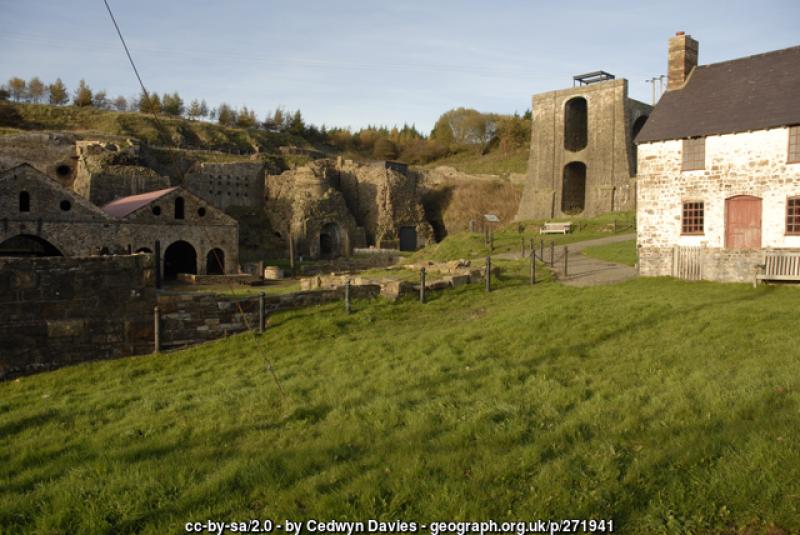
Blaenavon is still a close-knit community of people who have lived there all their lives, brought their children up who have also stayed and married within the town, and so on. But it has suffered in recent decades from the loss of the mines and a big downturn economically that even the world heritage status has failed to alleviate.
Thus, my upbringing gave me a huge sense of the importance of family and community, and a need to belong. The feeling that Wales is home never left me because we always came back. Although we moved to England for my father’s work, every holiday we ‘went home’ to visit the vast network of family and friends, and, after 20 years back in Wales, I still get a thrill when driving through the spectacular countryside and the little streets and lanes of my childhood, that I am ‘home’ again.
The chapel side of my upbringing also gave me a sense of duty (without meaning to sound pious) and a continuing faith, and, being part of a community where it was important to stop and chat to your neighbours and friends whenever you met them, I have an abiding interest in the lives of others!!
AmeriCymru: When did you first become aware that you wanted to write?
Julie: I had always loved English literature lessons at school, and went through the common habit of writing poetry (seen by no-one) to describe my teenage angst. However, the desire to write properly came about when we were living at a private school where my husband was headmaster. As the headmaster’s wife in such a school it was always one’s fate to be roped into something that no-one else wanted to do. I had been a keen participant of amateur dramatics since a child, so when there was no-one to run the school annual drama performance, that task fell to me. I then discovered that it was nearly impossible to find a script that had sufficient parts for all the children I needed to get on stage. So, in my rather typical ‘gung-ho’ fashion, I decided to write one, and that was my first foray into writing. Not only was it well-received, but I found myself enjoying it enormously and decided that I would embark on writing as a part-time career. I felt that I had at least one novel in me, but, given the work ethic that a Welsh chapel upbringing had impressed upon me, I couldn’t justify writing as an indulgence if it wasn’t going to pay. So I started writing commercial short stories, and only when they were being bought and published did I feel that I could also give novel-writing a go.
AmeriCymru: Your first novel The Mountains Between enjoyed considerable success. Care to describe it for our readers?
Julie: ‘The Mountains Between’ is set in my favourite part of the world – Blaenavon and Abergavenny – between the years of 1929 and 1949 and follows the fortunes of Jennie, youngest daughter of a prosperous farming family who live just outside Abergavenny, and of Harry, youngest son of a family living just the other side of the Blorenge mountain in Blaenavon; a very different existence marked by poverty and unemployment.
Jennie is just 8 years old, living a difficult, though comfortable life, under the critical eye of her harsh, autocratic mother, Katharine. At the start of the book Katharine has just told Jennie that she was never wanted. This rejection haunts Jennie throughout her childhood and, ten years later, spins her into a hasty marriage as World War 2 breaks out. The malign influence of Katharine continues to spoil her life and ultimately she has to make the decision to take charge of her life if she is ever to overcome her sense of unworthiness.
Harry, meanwhile, although poor, is surrounded by people he loves and who love him. At the start of the book he is 15, desperate to be a man and go down the pit, but ends up working in the local co-operative store. He is also desperate to find a girlfriend, and the first section of the book follows his fortunes in this department. But life grows harsher still as the Depression hits the community hard, and by the outbreak of the Second World War Harry is already a young man who has known much sadness and heartbreak.
Do Jennie and Harry ever meet? Do they each find someone to love? You have to read the book to find out!
‘The Mountains Between’ came about after I started recording the memoirs of my parents and realised that not only did they give a fantastic insight into life in the early part of the 20th century, but also that they had had such different upbringings that it was a wonder they ever got together – and so the idea for a novel was sparked. All of the places and big events that happen in the book are real, only the story is fictionalised.
AmeriCymru: Your second novel is set in Cornwall. What can you tell us about Just One More Summer ?
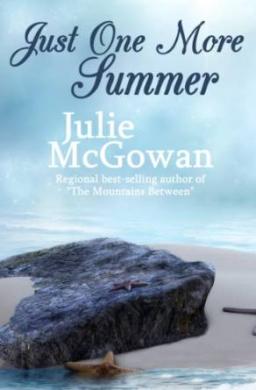
However, the premise of the book is that Allie, at nearly 30, is recovering from a broken marriage and decides to spend the summer in Cornwall, the place of long-remembered childhood happiness, in order to lick her wounds. She herself is the product of a broken marriage and had vowed that when her turn came she would have a long and happy partnership, so she was devastated when her husband left her. In Cornwall she strikes up a friendship with an unlikely group of young people who appear to be led by an ageing hippy-type of woman, Marsha. Allie discovers that the other members of the group have all been ‘rescued’ at one time or another by Marsha, who helps Allie to find her own hidden strength. But as Allie finds herself falling for one of the young men, Adam, she also discovers that Marsha has secrets of her own, that Allie’s idyllic memories of childhood are flawed, and that back in London family issues have become ever more complicated. And at this point her husband, Will, decides that he wants to give their marriage a second chance.
Again, to find out what happens to Allie, you will have to read the book!
AmeriCymru: Your third novel Don''t Pass Me By is about a group of children evacuated to rural Wales from wartime London. Care to tell us more?
Julie: When I was researching World War 2 for my first book, I read a lot of accounts from people who were evacuated during the Blitz to South Wales. It struck me that these days we tend to look back on this mass evacuation of children with nostalgic rose-coloured glasses, but, in reality, whilst some children were very well cared-for, others had a really bad time with their ‘foster’ parents. At the same time I was writing features for magazines about how we agonise these days when our children leave home to go to college; will they be safe, will they be happy, will they manage? And these are 18-year-olds! Yet, in the Blitz, these small children of 5 years upwards were sent across the country to goodness-knew-where to live with complete strangers.
So I increasingly felt I wanted to write a book which reflected some of the things that evacuee children encountered.
‘Don’t Pass Me By’ has three main characters:
Lydia is a young woman who is desperate to escape from her violent husband, and joins an evacuee train with her young baby in order to get away. Once in the tiny village of Penfawr, near Swansea, the billeting officer has no idea what to do with her, as she’s not on his list, so she is foisted onto the unwelcoming local doctor, to act as his housekeeper.
Arthur is a young lad from the East End who just wants to go back to the life he led with his mother – who leads a rackety sort of existence, the immorality of which Arthur is only vaguely aware of. He loses contact with his mother during his time in Penfawr and subsequently causes a lot of headaches for the kind family who have taken him in.
Amy is also from the East End, a timid child who is scared of the dark. She is placed with the bitter, God-fearing widow, Mrs Preece, and her strange son, Edwin. Amy suffers terribly during her time in this household and doesn’t know who to turn to.
The stories of these 3 characters intertwine throughout the book and, ultimately, none of them can help themselves without helping each other.
AmeriCymru: You have also been involved with local theatre in your home town of Usk. Is theatrical writing something that you might explore in the future?
Julie: I run the local theatrical group with my husband, and write all the scripts for our shows and our annual pantomime – a strange, very British concept – and sell these scripts via my website.( www.juliemcgowan.com ) I really enjoy this work, especially as most of it is humorous, so is very different from much of my other writing, but I don’t have a burning ambition to write for the theatre in any other way. I think my scriptwriting is too light-hearted for modern theatre which seems to need a lot of depth and angst and to be more obscure.
AmeriCymru: What are you reading currently? Any recommendations?
Julie: I’ve just finished reading ‘All Change’, the 5th and final volume of the Cazalet Chronicles by Elizabeth Jane Howard. The books are a wonderful evocation of English upper middle class life and I’ve enjoyed them enormously. Each volume can stand alone, but I would recommend that anyone who is interested should really start with volume one ‘The Light Years’ and work their way through the whole series.
I’ve also just read ‘The Testament of Mary’ by Colm Toibin, which was shortlisted for the Booker Prize. It’s Mary’s account of what happened at the crucifixion – beautifully written, but I’m going to read it again as I’ve been discussing it with a friend and we’ve come away from it with completely different views!
One of my favourites from last year was ‘Me Before You’ by Jojo Moyes – a brilliant book which took me by surprise with its depth and emotion when I thought it was going to be quite light and frothy.
AmeriCymru: What''s next for Julie McGowan? Are you working on another book at the moment?
Julie: Yes, I am working on another book, but it’s slow going when I have to currently spend a lot of time promoting ‘Don’t Pass Me By’! The working title of this next one is ‘Yes I’m gonna be a star’ and it’s the story of a teenage girl in 1971, who decides that she wants to be a famous singer, and goes off to London to do just that. She succeeds, but there are dreadful costs to pay along the way.
AmeriCymru: Any final message for the readers and members of AmeriCymru?
Julie: I am very grateful for the opportunity to promote my books with you. I sincerely hope that ‘The Mountains Between’ and ‘Don’t Pass Me By’ fill readers with nostalgia and love for ‘the old country’ and that they enjoy reading them as much as I’ve enjoyed writing them. I would love some reviews (good or bad, but hopefully good!) on Amazon, Goodreads, and any other book-based sites, and welcome emails from readers ( juliemcgowanusk@live.co.uk ) And finally, congratulations to all at AmeriCymru for the work you do in promoting all things Welsh – if any of your members are ever in this part of S. Wales I would happily give them a guided tour of my little part of it.
Product Details
Available in Paperback
We have had no winter here in the San Joaquin Valley of California. The days have remained in the upper 60's and 70's throughout the months of January, rarely dropping lower since our very brief autumn in November.
I awoke Thursday morning to the feeling of a definite shift in the Earth's energy. The quickening has begun; Imbolc is upon us, a week early. I suspect an early spring and a long, long, hot, dry summer here; the governor of California has already declared a drought. (Something those of us who are paying attention already knew long ago.) The Valley is rapidly returning to the desert it once was thousands of years ago, hastened by the hand of Man.


